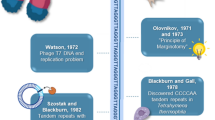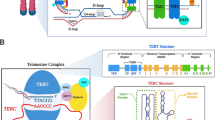Abstract
Implantation rate decreases and miscarriage rate increases with advancing maternal age. The oocyte must be the locus of reproductive aging because donation of oocytes from younger to older women abrogates the effects of aging on fecundity. Nuclear transfer experiments in a mouse model of reproductive aging show that the reproductive aging phenotype segregates with the nucleus rather than the cytoplasm. A number of factors within the nucleus have been hypothesized to mediate reproductive aging, including disruption of cohesions, reduced chiasma, aneuploidy, disrupted meiotic spindles, and DNA damage caused by chronic exposure to reactive oxygen species. We have proposed telomere attrition as a parsimonious way to explain these diverse effects of aging on oocyte function. Telomeres are repetitive sequences of DNA and associated proteins, which form a loop (t loop) at chromosome ends. Telomeres prevent the blunt end of DNA from triggering a DNA damage response. Previously, we showed that experimental telomere shortening phenocopies reproductive aging in mice. Telomere shortening causes reduced synapsis and chiasma, chromosome fusions, embryo arrest and fragmentation, and abnormal meiotic spindles. Telomere length of polar bodies predicts the fragmentation of human embryos. Telomerase, the reverse transcriptase capable of reconstituting shortened telomeres, is only minimally active in oocytes and preimplantation embryos. Intriguingly, during the first cell cycles following activation, telomeres robustly elongate via a DNA double-strand break mechanism called alternative lengthening of telomeres (ALTs). Alternative lengthening of telomere takes place even in telomerase-null mice. This mechanism of telomere elongation previously had been found only in cancer cells lacking telomerase activity. We propose that ALT elongates telomeres across generations but does so at the cost of extensive genomic instability in preimplantation embryos.
Similar content being viewed by others
References
Sauer MV. Reproduction at an advanced maternal age and maternal health. Fertil steril. 2015;103(5):1136–1143. doi:10.1016/j. fertnstert.2015.03.004.
Soderberg M, Christensson K, Lundgren I, Hildingsson I. Women’s attitudes towards fertility and childbearing - A study based on a national sample of Swedish women validating the Attitudes to Fertility and Childbearing Scale (AFCS). Sex Reprod Healthc. 2015;6(2):54–58. doi:10.1016/j.srhc.2015.01.002.
Forman EJ, Treff NR, Scott R. Jr. Fertility after age 45: From natural conception to Assisted Reproductive Technology and beyond. Maturitas. 2011;70(3):216–221. doi:10.1016/j.maturitas. 2011.07.003.
Liu L, Keefe DL. Nuclear origin of aging-associated meiotic defects in senescence-accelerated mice. Biol Reprod. 2004; 71(5):1724–1729. doi:10.1095/biolreprod.l04.028985.
Keefe DL, Liu L. Telomeres and reproductive aging. Reprod Fertil Dev. 2009;21(1):10–14.
Forsyth NR, Wright WE, Shay JW. Telomerase and differentiation in multicellular organisms: turn it off, turn it on, turn it off again. Differentiation. 2002;69(4-5):188–197. doi:10.1046/j.1432-0436.2002.690412.X.
Herbig U, Ferreira M, Condel L, Carey D, Sedivy JM. Cellular senescence in aging primates. Science. 2006;311(5765):1257.
Herbig U, Jobling WA, Chen BP, Chen DJ, Sedivy JM. Telomere shortening triggers senescence of human cells through a pathway involving ATM, p53, and p21(CIPl), but not p16(INK4a). Mol Cell. 2004;14(4):501–513.
Blackburn EH. Structure and function of telomeres. Nature. 1991; 350(6319):569–573. doi: 10.1038/350569a0.
de Lange T. Shelterin: the protein complex that shapes and safeguards human telomeres. Genes Dev. 2005;19(18):2100–2110. doi:10.1101/gad.l346005.
de Lange T. Telomere biology and DNA repair: enemies with benefits. FEBS Lett. 2010;584(17):3673–3674. doi:10.1016/j.febslet.2010.07.030.
de Lange T. Protection of mammalian telomeres. Oncogene. 2002;21(4):532–540.doi: 10.1038/sj.onc.1205080.
Collerton J. Martin-Ruiz C, Kenny A, et al. Newcastle 85+ Core Study, Telomere length is associated with left ventricular function in the oldest old: the Newcastle 85+ study. Eur Heart J. 2007;28(2):172–176. doi:10.1093/eurheartj/eh1437.
Richter T, von Zglinicki T. A continuous correlation between oxidative stress and telomere shortening in fibroblasts. Exp Gerontol. 2007;42(11):1039–1042. doi: 10.1016/j.exger.2007.08.005.
Jurk D, Wang C, Miwa S, et al. Postmitotic neurons develop a p21-dependent senescence-like phenotype driven by a DNA damage response. Aging Cell. 2012;11(6):996–1004. doi:10.1111/j.1474-9726.2012.00870.X.
Herbig U, Sedivy JM. Regulation of growth arrest in senescence: telomere damage is not the end of the story. Mech Ageing Dev. 2006;127(1):16–24. doi:10.1016/j.mad.2005.09.002.
Keefe DL. Telomeres and meiosis in health and disease. Cell Mol Life Sci. 2007;64(2):115–116. doi:10.1007/s00018-006-6462-3.
Keefe DL, Marquard K, Liu L. The telomere theory of reproductive senescence in women. Curr Opin Obstet Gynecol. 2006; 18(3):280–285. doi:10.1097/01.gco.0000193019.05686.49.
Felicio LS, Nelson JF, Gosden RG, Finch CE. Restoration of ovulatory cycles by young ovarian grafts in aging mice: potentiation by long-term ovariectomy decreases with age. Proc Natl Acad Sci U S A. 1983;80(19):6076–6080.
Keefe DL, Michelson DS, Lee SH, Naftolin F. Astrocytes within the hypothalamic arcuate nucleus contain estrogen-sensitive peroxidase, bind fluorescein-conjugated estradiol, and may mediate synaptic plasticity in the rat. Am J Obstet Gynecol. 1991;164(4):959–966.
Liu L, Blasco MA, Keefe DL. Requirement of functional telomeres for metaphase chromosome alignments and integrity of meiotic spindles. EMBO Rep. 2002;3(3):230–234. doi:10.1093/embo-reports/kvf055.
Keefe DL, Franco S, Liu L, et al. Telomere length predicts embryo fragmentation after in vitro fertilization in women— toward a telomere theory of reproductive aging in women. Am J Obstet Gynecol. 2005;192(4):1256–1260. discussion 1260-1261.doi:10.1016/j.ajog.2005.01.036.
Liu L, Franco S, Spyropoulos B, Moens PB, Blasco MA, Keefe DL. Irregular telomeres impair meiotic synapsis and recombination in mice. Proc Natl Acad Sci USA. 2004;101(17):6496–6501. doi:10.1073/pnas.0400755101.
Lee HW, Blasco MA, Gottlieb GJ, Horner J. II, Greider CW, DePinho RA. Essential role of mouse telomerase in highly proliferative organs. Nature. 1998;392(6676):569–574.
Gray KE, Schiff MA, Fitzpatrick AL, Kimura M, Aviv A, Starr JR. Leukocyte telomere length and age at menopause. Epidemiology. 2014;25(1):139–146. doi:10.1097/EDE.0000000000000017.
Hanna CW, Bretherick KL, Gair JL, Fluker MR, Stephenson MD, Robinson WP. Telomere length and reproductive aging. Hum Reprod. 2009;24(5):1206–1211. doi:10.1093/humrep/dep007.
Ghosh S, Feingold E, Chakraborty S, Dey SK. Telomere length is associated with types of chromosome 21 nondisjunction: a new insight into the maternal age effect on Down syndrome birth. Hum Genet. 2010;127(4):403–409. doi:10.1007/s00439-009-0785-8.
Ray A, Hong CS, Feingold E, et al. Maternal telomere length and risk of Down syndrome: epidemiological impact of smokeless chewing tobacco and oral contraceptive on segregation of chromosome 21. Public Health Genomics. 2016;19(1):11–18. doi:10. 1159/000439245.
Keefe DL, Liu L, Marquard K. Telomeres and aging-related meiotic dysfunction in women. Cell Mol Life Sci. 2007; 64(2)139–143. doi:10.1007/s00018-006-6466-z.
Treff NR, Su J, Taylor D, Scott R. Jr. Telomere DNA deficiency is associated with development of human embryonic aneuploidy. PLoS Genet. 2011;7(6):e1002161. doi:10.1371/journal.pgen.1002161.
Henderson SA, Edwards RG. Chiasma frequency and maternal age in mammals. Nature. 1968;218(5136):22–28.
Polani PE, Crolla JA. A test of the production line hypothesis of mammalian oogenesis. Hum Genet. 1991;88(1):64–70.
Abizaid A, Horvath B, Keefe DL, Leranth C, Horvath TL. Direct visual and circadian pathways target neuroendocrine cells in primates. Eur J Neurosci. 2004;20(10):2767–2776. doi:10.1111/j.1460-9568.2004.03737.X.
Liu J, Liu M, Ye X, et al. Delay in oocyte aging in mice by the antioxidant N-acetyl-L-cysteine (NAC). Hum Reprod. 2012;27(5):1411–1420. doi:10.1093/humrep/des019.
Antunes DM, Kalmbach KH, Wang F, et al. A single-cell assay for telomere DNA content shows increasing telomere length heterogeneity, as well as increasing mean telomere length in human spermatozoa with advancing age. J Assist Reprod Genet. 2015; 32(11):1685–1690. doi:10.1007/sl0815-015-0574-3.
Liu L, Di Girolamo CM, Navarro PA, Blasco MA, Keefe DL. Telomerase deficiency impairs differentiation of mesenchymal stem cells. Exp Cell Res. 2004;294(1):1-8. doi:10.1016/j.yexcr.2003.10.031.
Huang J, Wang F, Okuka M, et al. Association of telomere length with authentic pluripotency of ES/iPS cells. Cell Res. 2011;21(5):779–792. doi:10.1038/cr.2011.16.
Huang J, Okuka M, Lu W, et al. Telomere shortening and DNA damage of embryonic stem cells induced by cigarette smoke. Reprod Toxicol. 2013;35:89–95. doi:10.1016/j.reprotox.2012.07. 003.
Huang J, Okuka M, Wang F, et al. Generation of pluripotent stem cells from eggs of aging mice. Aging Cell. 2010;9(2):113–125. doi: 10.1111/J.1474-9726.2009.00539.X.
Agarwal S, Loh YH, McLoughlin EM, et al. Telomere elongation in induced pluripotent stem cells from dyskeratosis congenita patients. Nature. 2010;464(7286):292–296. doi:10.1038/ nature08792.
Liu L, Bailey SM, Okuka M, et al. Telomere lengthening early in development. Nat Cell Biol. 2007;9(12):1436–1441. doi:10.1038/ncb 1664.
Wright WE, Piatyszek MA, Rainey WE, Byrd W, Shay JW. Telomerase activity in human germline and embryonic tissues and cells. Dev genet. 1996;18(2):173–179.
Adjaye J, Daniels R, Bolton V, Monk M. cDNA libraries from single human preimplantation embryos. Genomics. 1997;46(3):337–344. doi:10.1006/geno.1997.5117.
Draskovic I, Londono Vallejo A. Telomere recombination and alternative telomere lengthening mechanisms. Front Biosci (Landmark ed). 2013;18:1–20.
Author information
Authors and Affiliations
Corresponding author
Rights and permissions
About this article
Cite this article
Keefe, D.L. Telomeres, Reproductive Aging, and Genomic Instability During Early Development. Reprod. Sci. 23, 1612–1615 (2016). https://doi.org/10.1177/1933719116676397
Published:
Issue Date:
DOI: https://doi.org/10.1177/1933719116676397




